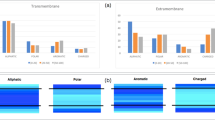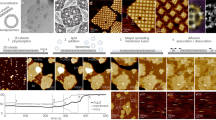Abstract
The frequent occurrence of β-sheet promoting residues such as Ile, Val, and Thr in the α-helical transmembrane segments of most integral membrane proteins suggests that the helical propensities of these residues are altered in the hydrophobic environment of the lipid bilayer. Systematic studies of peptides by circular dichroism models spectroscopy in various micellar/vesicular media allow the establishment of a ranking order of helical propensity for uncharged amino acids in the membrane environment. In contrast to their conformational preferences in water, the helical proclivity of amino acids in membranes is shown to be governed by their side chain hydrophobicity, and by the hydropathy of the local peptide segments in which the residues reside.
This is a preview of subscription content, access via your institution
Access options
Subscribe to this journal
Receive 12 print issues and online access
$189.00 per year
only $15.75 per issue
Buy this article
- Purchase on Springer Link
- Instant access to full article PDF
Prices may be subject to local taxes which are calculated during checkout
Similar content being viewed by others
References
Blaber, M., Zhang, X.-J. & Matthews, B.W. Structural basis of amino acid α-helix propensity. Science 260, 1637–1643 (1993).
Padmanabhan, S., Marqusee, S., Ridgeway, T., Laue, T.M. & Baldwin, R.L. Relative helix-forming tendencies of nonpolar amino acids. Nature 344, 268–270 (1990).
Lyu, P.C., Liff, M.I., Marky, L.A. & Kallenbach, N.R. Side chain contributions to the stability of α-helical structure in peptides. Science 250, 669–673 (1990).
O'Neil, K.T. & DeGrado, W.F. A thermodynamic scale for the helix-forming tendencies of the commonly occurring amino acids. Science 250, 646–651 (1990).
Chou, P.Y. & Fasman, G.D. Empirical predictions of protein conformation. A. Rev. Biochem. 47, 251–276 (1978).
Kopito, R.R. & Lodish, H.F. Primary structure and transmembrane orientation of the murine anion exchange protein. Nature 316, 234–238 (1985).
Popot, J.-L. & de Vitry, C. On the microassembly of integral membrane proteins. A. Rev. Biophys. biophys. Chem. 19, 369–403 (1990).
Jennings, M.L. Topography of membrane proteins. A. Rev. Biochem. 58, 999–1027 (1989).
Deber, C.M., Brandl, C.J., Deber, R.B., Hsu, L.C. & Young, X.K. Amino acid composition of the membrane and aqueous domains of integral membrane proteins. Arch. Biochem. Biophys. 251, 68–76 (1986).
Landolt-Marticorena, C., Williams, K.A., Deber, C.M. & Reithmeier, R.A.F. Non-random distribution of amino acids in the transmembrane segments of human type I single span membrane proteins. J. molec. Biol. 229, 602–608 (1993).
Li, S.-C. & Deber, C.M. Influence of glycine residues on peptide conformation in membrane environments. Int. J. peptide protein Res. 40, 243–248 (1992).
Wallace, B.A., Cascio, M. & Mielke, D.L. Evaluation of methods for the prediction of membrane protein secondary structures. Proc. natn. Acad. Sci. U.S.A. 83, 9423–9427 (1986).
Li, S.-C. & Deber, C.M. Peptide environment specifies conformation. Helicity of hydrophobic segments compared in aqueous, organic, and membrane environments. J. biol. Chem. 268, 22975–22978 (1993).
Li, S.-C. & Deber, C.M. Glycine and β-branched residues support and modulate peptide helicity in membrane environments. FEBS Lett. 311, 217–220 (1992).
Gasset, M. et al. Predicted α-helical regions of the prion protein when synthesized as peptides form amyloid. Proc. natn. Acad. Sci. U.S.A. 89, 10940–10944 (1992).
van de Ven, F.J.M. et al. Assignment of 1H, 15N, and backbone 13C resonances in detergent-solubilized M13 coat protein via multinuclear multidimensional NMR: a model for the coat protein monomer. Biochemistry 32, 8322–8328 (1993).
Hoyt, D.W. & Gierasch, L.M. Hydrophobic content and lipid interactions of wild-type and mutant OmpA signal peptides correlate with their in vivo function. Biochemistry 30, 10155–10163 (1991).
Gordon, L.M., Curtain, C.C., Zhong, Y.C., Kirkpatrick, A., Mobley, P.W. & Waring, A.J. The amino-terminal peptide of HIV-1 glycoprotein 41 interacts with human erythrocyte membranes: peptide conformation, orientation and aggregation. Biochim. biophys. Acta 1139, 257–274 (1992).
Roth, M., Lewit-Bentley, A., Michel, H., Deisenhofer, J., Huber, R. & Oesterhelt, D. Detergent structure in crystals of a bacterial photosynthetic reaction centre. Nature 340, 659–662 (1989).
Barber, J. Detergent ringing true as a model for membranes. Nature 340, 601 (1989).
Yang, J.T., Wu, C.-S.C. & Martinez, H.M. Calculation of protein conformation from circular dichroism. Meth. Enzymol. 130, 208–269 (1986).
Park, K., Perczel, A. & Fasman, G.D. Differentiation between transmembrane helices and peripheral helices by the deconvolution of circular dichroism spectra of membrane proteins. Prot. Sci. 1, 1032–1049 (1992).
Heinz, D.W., Baase, W.A. & Matthews, B.W. Folding and function of a T4 lysozyme containing 10 consecutive alanines illustrate the redundancy of information in an amino acid sequence. Proc. natn. Acad. Sci. U.S.A. 89, 3751–3755 (1992).
Zhong, L. & Johnson, C., Jr. Environment affects amino acid preference for secondary structure. Proc. natn. Acad. Sci. U.S.A. 89, 4462–4465 (1992).
Kyte, J. & Doolittle, R.F. A simple method for displaying the hydropathic character of a protein. J. molec. Biol. 157, 105–132 (1982).
Blaber, M., Zhang, X.-J. & Matthews, B.W. Alpha helix propensity of amino acids. Science 262, 917–918 (1993).
Shortle, D. & Clarke, N. Alpha helix propensity of amino acids. Science 262, 917 (1993).
Engelman, D.E., Steitz, T.A. & Goldman, A. Identifying nonpolar transmembrane helices in amino acid sequences of membrane proteins. A. Rev. Biophys. biophys. Chem. 15, 321–353 (1986).
Alber, T. Stabilization energies of protein conformation. In Prediction of Protein Structure and the Principles of Protein Conformation (ed. Fasman, G. D.), 161–192 Plenum (1989).
Kamtekar, S., Schiffer, J.M., Xiong, H., Babik, J.M. & Hecht, M.H. Protein design by binary patterning of polar and nonpolar amino acids. Science 262, 1680–1685 (1993).
Wattenberger, M.R., Chan, H.S., Evans, D.F., Bloomfield, V.A. & Dill, K.A. Surface-induced enhancement of internal structure in polymers and proteins. J. chem. Phys. 93, 8343–8351 (1990).
Chan, H.S., Wattenberger, M.R., Evans, D.F., Bloomfield, V.A. & Dill, K.A. Enhanced structure in polymers at interfaces. J. chem. Phys. 94, 8542–8557 (1991).
Jacobs, R.E. & White, S.H. The nature of the hydrophobic binding of small peptides at the bilayer interface: implications for the insertion of transbilayer helices. Biochemistry 28, 3421–3437 (1989).
Engelman, D.M. & Steitz, T.A. The spontaneous insertion of proteins into and across membranes: the helical hairpin hypothesis. Cell 23, 411–422 (1981).
Kaiser, E.T. & Kezdy, F.J. Secondary structures of proteins and peptides in amphiphilic environments (A review). Proc. natn. Acad. Sci. U.S.A. 80, 1137–1143 (1983).
Wiener, M. C. & White, S. H. Structure of a fluid dioleoylphosphatidylcholine bilayer determined by joint refinement of X-ray and neutron diffraction data. III. Complete structure. Biophys. J. 61, 434–447 (1992).
White, S.H. & Wimley, W.C. Peptides in lipid bilayers: structural and thermodynamic basis for partitioning and folding. Curr. Opin. struct. Biol. 4, 79–86 (1994).
Atherton, E. & Sheppard, R.C. in Solid Phase Peptide Synthesis, A Practical Approach (eds. Rickwood, D. & Hames, B.D.), 131–148 (IRL Press, Oxford, U.K., 1990).
Author information
Authors and Affiliations
Rights and permissions
About this article
Cite this article
Li, SC., Deber, C. A measure of helical propensity for amino acids in membrane environments. Nat Struct Mol Biol 1, 368–373 (1994). https://doi.org/10.1038/nsb0694-368
Received:
Accepted:
Issue Date:
DOI: https://doi.org/10.1038/nsb0694-368
This article is cited by
-
TMalphaDB and TMbetaDB: web servers to study the structural role of sequence motifs in α-helix and β-barrel domains of membrane proteins
BMC Bioinformatics (2015)
-
Investigating the effect of a single glycine to alanine substitution on interactions of antimicrobial peptide latarcin 2a with a lipid membrane
European Biophysics Journal (2011)
-
Transverse and tangential orientation of predicted transmembrane fragments 4 and 10 from the human multidrug resistance protein (hMRP1/ABCC1) in membrane mimics
European Biophysics Journal (2011)
-
Efficient molecular mechanics simulations of the folding, orientation, and assembly of peptides in lipid bilayers using an implicit atomic solvation model
Journal of Computer-Aided Molecular Design (2011)
-
An intramembrane aromatic network determines pentameric assembly of Cys-loop receptors
Nature Structural & Molecular Biology (2010)



